 5
5  5
5  2
2 RS = 12.2 in ⇒ answer (a)
Step-by-step explanation:
∵ m∠R = 78° , m∠T = 39° , TS = 19
∵ By using sin Rule:
∵ ST/sin∠R = RS/sin∠T
∴ 19/sin78 = RS/sin39
∴ RS = (19 × sin39) ÷ sin 78 = 12.2 in ⇒ answer (a)
 2
2 RS = 12.2 in ⇒ answer (a)
Step-by-step explanation:
∵ m∠R = 78° , m∠T = 39° , TS = 19
∵ By using sin Rule:
∵ ST/sin∠R = RS/sin∠T
∴ 19/sin78 = RS/sin39
∴ RS = (19 × sin39) ÷ sin 78 = 12.2 in ⇒ answer (a)
 10
10 for Derek's collection :
Mean= 1929
Median= 1930
Range= 54
IQR = 48
MAD= 23.75
for Paul's collection:
Mean= 1929
Median= 1929.5
Range= 15
IQR = 6
MAD= 3.5
Step-by-step explanation:Derek's collection:
1950, 1952, 1908, 1902, 1955, 1954, 1901, 1910
Mean is given by:

Now absolute deviation from mean is:
|1950-1929|= 21
|1952-1929|= 23
|1908-1929|= 21
|1902-1929|= 27
|1955-1929|= 26
|1954-1929|= 25
|1901-1929|= 28
|1910-1929|= 19
and the mean of these absolute deviation gives the MAD of the data i.e.

Now, on arranging the data in increasing order we get:
1901 1902 1908 1910 1950 1952 1954 1955
The least value is: 1901
Maximum value is: 1955
Range is: Maximum value-Least value
Range=1955-1901
Range= 54
Also, the median lie between 1910 and 1950 and is calculated as:
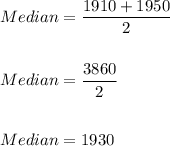
Also, the lower set of data is:
1901 1902 1908 1910
and the median of lower set of data also known as first quartile or lower quartile is:
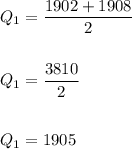
and upper set of data is:
1950 1952 1954 1955
and the median of upper set of data i.e. upper quartile or third quartile is:
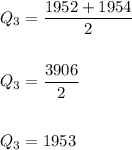
Hence, IQR is calculated as:
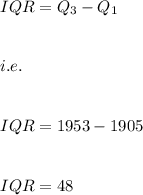
Paul's collection:
1929, 1935, 1928, 1930, 1925, 1932, 1933, 1920
Mean is given by:

Now absolute deviation from mean is:
|1929-1929|=0
|1935-1929|= 6
|1928-1929|= 1
|1930-1929|= 1
|1925-1929|= 4
|1932-1929|= 3
|1933-1929|= 4
|1920-1929|= 9
Hence, we get:
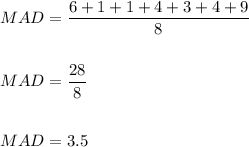
Now, on arranging the data in increasing order we get:
1920 1925 1928 1929 1930 1932 1933 1935
Least value= 1920
Maximum value= 1935
Range= 15 ( Since, 1935-1920=15 )
The median lie between 1929 and 1930
Hence, Median= 1929.5
Also, lower set of data is:
1920 1925 1928 1929
and median of lower set of data is the first quartile or upper quartile and is calculated as:

and the upper set of data is:
1930 1932 1933 1935
Hence, we get:

Hence, IQR is calculated as:
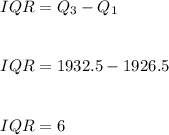
 3
3 Derek:
Mean:1929
Median: 1930
range: 54
IQR: 48
MAD: 23.75
Paul:
Mean: 1929
Median: 1929.5
range: 15
IQR: 6
MAD: 3.5
Step-by-step explanation:
 5
5 Step-by-step explanation:
Points plotted.
See the graph attached.
Correct choice is:
A. Yes, in the scatterplot the wavelike behavior is apparent although not precise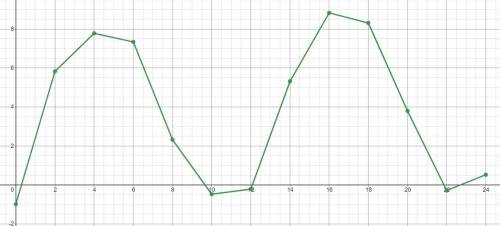
 10
10 for Derek's collection :
Mean= 1929
Median= 1930
Range= 54
IQR = 48
MAD= 23.75
for Paul's collection:
Mean= 1929
Median= 1929.5
Range= 15
IQR = 6
MAD= 3.5
Step-by-step explanation:Derek's collection:
1950, 1952, 1908, 1902, 1955, 1954, 1901, 1910
Mean is given by:

Now absolute deviation from mean is:
|1950-1929|= 21
|1952-1929|= 23
|1908-1929|= 21
|1902-1929|= 27
|1955-1929|= 26
|1954-1929|= 25
|1901-1929|= 28
|1910-1929|= 19
and the mean of these absolute deviation gives the MAD of the data i.e.

Now, on arranging the data in increasing order we get:
1901 1902 1908 1910 1950 1952 1954 1955
The least value is: 1901
Maximum value is: 1955
Range is: Maximum value-Least value
Range=1955-1901
Range= 54
Also, the median lie between 1910 and 1950 and is calculated as:

Also, the lower set of data is:
1901 1902 1908 1910
and the median of lower set of data also known as first quartile or lower quartile is:

and upper set of data is:
1950 1952 1954 1955
and the median of upper set of data i.e. upper quartile or third quartile is:

Hence, IQR is calculated as:

Paul's collection:
1929, 1935, 1928, 1930, 1925, 1932, 1933, 1920
Mean is given by:

Now absolute deviation from mean is:
|1929-1929|=0
|1935-1929|= 6
|1928-1929|= 1
|1930-1929|= 1
|1925-1929|= 4
|1932-1929|= 3
|1933-1929|= 4
|1920-1929|= 9
Hence, we get:

Now, on arranging the data in increasing order we get:
1920 1925 1928 1929 1930 1932 1933 1935
Least value= 1920
Maximum value= 1935
Range= 15 ( Since, 1935-1920=15 )
The median lie between 1929 and 1930
Hence, Median= 1929.5
Also, lower set of data is:
1920 1925 1928 1929
and median of lower set of data is the first quartile or upper quartile and is calculated as:

and the upper set of data is:
1930 1932 1933 1935
Hence, we get:

Hence, IQR is calculated as:

 3
3 Derek:
Mean:1929
Median: 1930
range: 54
IQR: 48
MAD: 23.75
Paul:
Mean: 1929
Median: 1929.5
range: 15
IQR: 6
MAD: 3.5
Step-by-step explanation:
 8
8 Al(NO₃)₃ > KI > HF > CH₃OH
Explanation:
The electrical conductivities of the solutions will depend on the concentration of ions in solution.
Al(NO₃)₃ solution contains 0.1 M of Al³⁺ ions and 0.3 M of NO₃⁻ ions
KI solution contains 0.1 M of K⁺ ions and 0.1 M of I⁻ ions
HF solution contains less than 0.1 M of H⁺ ions and less then 0.1 M of F⁻ ions, because the HF acid will not dissociate completely
CH₃OH practically it does not dissociate, so in the solution will not be electrical conductive (comparative with the other solutions)
The solutions in order of decreasing intensity of the bulb are ranked as following:
Al(NO₃)₃ > KI > HF > CH₃OH

It will provide an instant answer!
